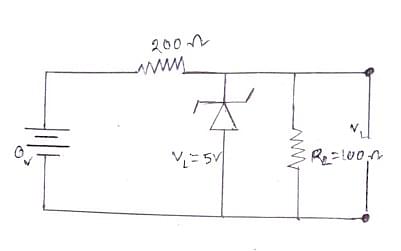A thick current carrying cable of radius $'R'$ carries current $'I'$ uniformly distributed across its cross-section. The variation of magnetic field $B ( r )$ due to the cable with the distance $'r'$ from the axis of the cable is represented by :
The Correct Option is C
Solution and Explanation
To solve the problem of the magnetic field variation inside a thick current-carrying cable, where the current is uniformly distributed across the cross-section, we will use the principles of magnetism and apply Ampere's Law.
Understanding the Problem:
We have a current-carrying cable with radius $R$ and a uniformly distributed current $I$. We need to determine how the magnetic field $B(r)$ changes with the distance $r$ from the cable's axis.
Theory and Formulae:
By Ampère's Law, the line integral of the magnetic field $B$ around a closed path is equal to $\mu_0$ times the current passing through the enclosed area:
$ \oint \mathbf{B} \cdot d\mathbf{l} = \mu_0 I_{enc} $Here, $I_{enc}$ is the current enclosed by the path. For a radial distance $r \leq R$, the magnitude of the magnetic field $B(r)$ inside the cable can be derived as follows:
- $dI = I \cdot \left( \frac{\pi r^2}{\pi R^2} \right) = I \cdot \frac{r^2}{R^2}$, the current enclosed by a circle of radius $r$.
- Thus, $B(r) \cdot 2 \pi r = \mu_0 \cdot \frac{I r^2}{R^2}$
- Therefore, $ B(r) = \frac{\mu_0 I r}{2 \pi R^2} $
Conclusion:
The magnetic field inside the cable increases linearly with the distance $r$ from the axis of the cable, and it is directly proportional to $ \frac{\mu_0 I}{R^2} $.

Hence, the correct option for the variation of magnetic field $B(r)$ inside the cable versus the distance $r$ is as shown in the above diagram.
Top Questions on Amperes circuital law
- A coil has a resistance of \( 30 \, \Omega \) and an inductive reactance of \( 20 \, \Omega \) at 50 Hz frequency. If an AC source of 200 V and 100 Hz is connected across the coil, then how much current will flow through the coil?
- MHT CET - 2024
- Physics
- Amperes circuital law
- In a series LCR circuit connected to an AC source, at resonance, the current is maximum because:
- MHT CET - 2024
- Physics
- Amperes circuital law
Consider the circuit shown :
 The ammeter reads 0.9 A. Value of R is
The ammeter reads 0.9 A. Value of R is- JEE Main - 2024
- Physics
- Amperes circuital law
- Among the following, Ampere’s circuital law is represented by:
- AP EAPCET - 2023
- Physics
- Amperes circuital law
- In the given circuit, find the voltage drop VL in the load resistance RL

- WBJEE - 2023
- Physics
- Amperes circuital law
Questions Asked in NEET exam
- A microscope has an objective of focal length \(f_o = 2\) cm and an eyepiece of focal length \(f_e = 4\) cm. The tube length of the microscope is \(L = 40\) cm. If the distance of distinct vision of eye is \(D = 25\) cm, the magnification in the microscope is:
- NEET (UG) - 2025
- Optical Instruments
- Which one of the following is an example of ex-situ conservation?
- NEET (UG) - 2025
- Ex-Situ Conservation
- Which one of the following compounds can exist as cis-trans isomers?
- NEET (UG) - 2025
- Organic Chemistry
- Who proposed that the genetic code for amino acids should be made up of three nucleotides?
- NEET (UG) - 2025
- Molecular Biology
- An electron (mass \(9 \times 10^{-31}\) kg and charge \(1.6 \times 10^{-19}\) C) moving with speed \(c/100\) (\(c\) = speed of light) is injected into a magnetic field of magnitude \(9 \times 10^{-4}\) T perpendicular to its direction of motion. We wish to apply a uniform electric field \( \vec{E} \) together with the magnetic field so that the electron does not deflect from its path. (speed of light \(c = 3 \times 10^8\) m/s):
- NEET (UG) - 2025
- Electric Field
Concepts Used:
Amperes circuital law
According to Ampere’s law, magnetic fields are related to the electric current that is produced in them. This law specifies that the magnetic field is associated with a given current or vice-versa, provided that the electric field doesn’t change with time.
Ampere’s circuital law can be written as the line integral of the magnetic field surrounding the closed loop which is equal to the number of times the algebraic sum of currents passing through the loop.

According to the second equation, if the magnetic field is integrated along the blue path, then it is equal to the current enclosed, I.
The magnetic field doesn’t vary at a distance r because of symmetry. The path length (in blue) in figure 1 has to be equal to the circumference of a circle,2πr.



